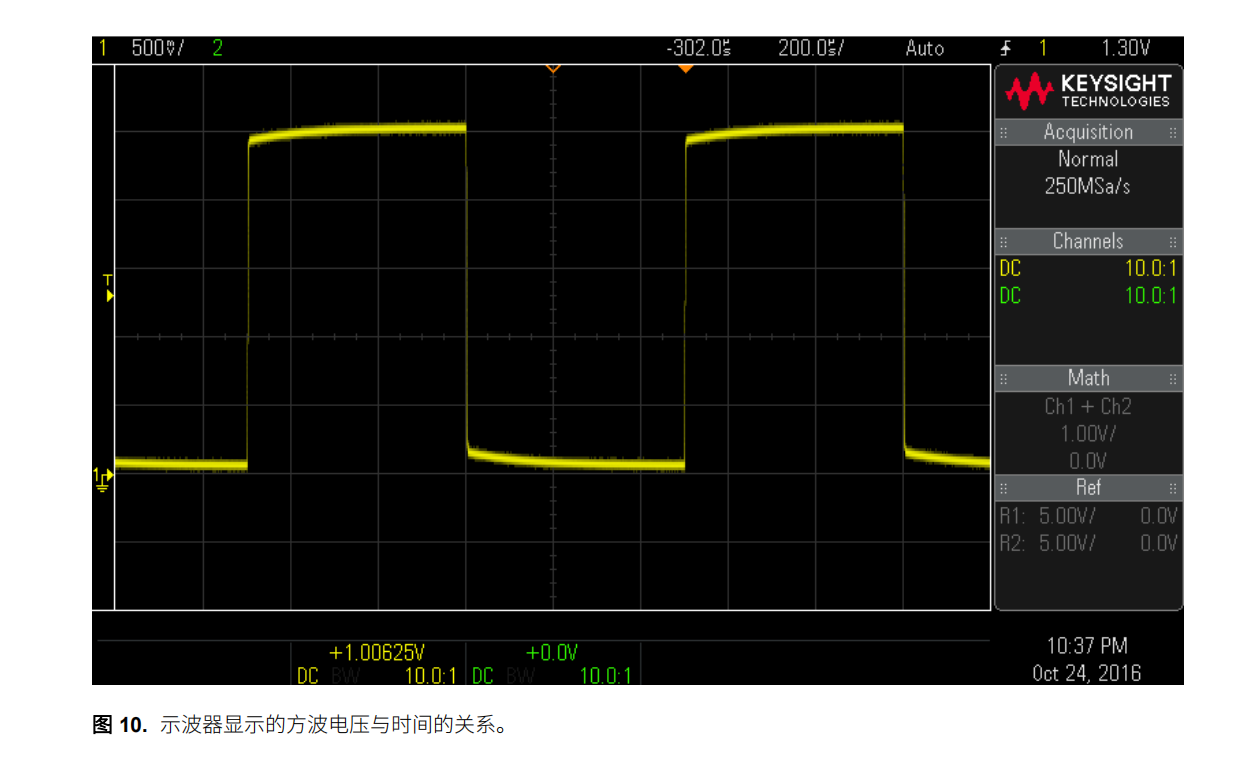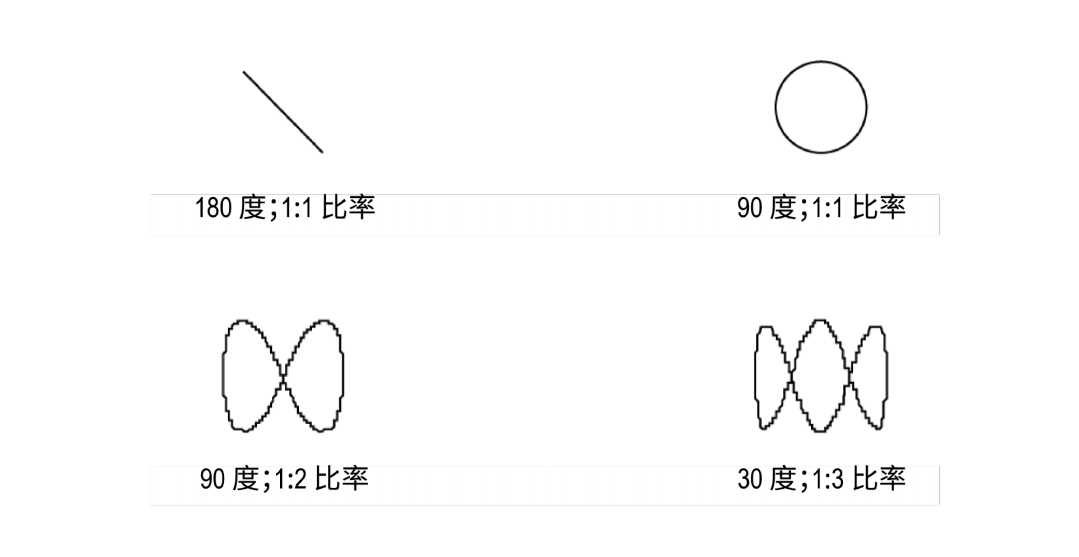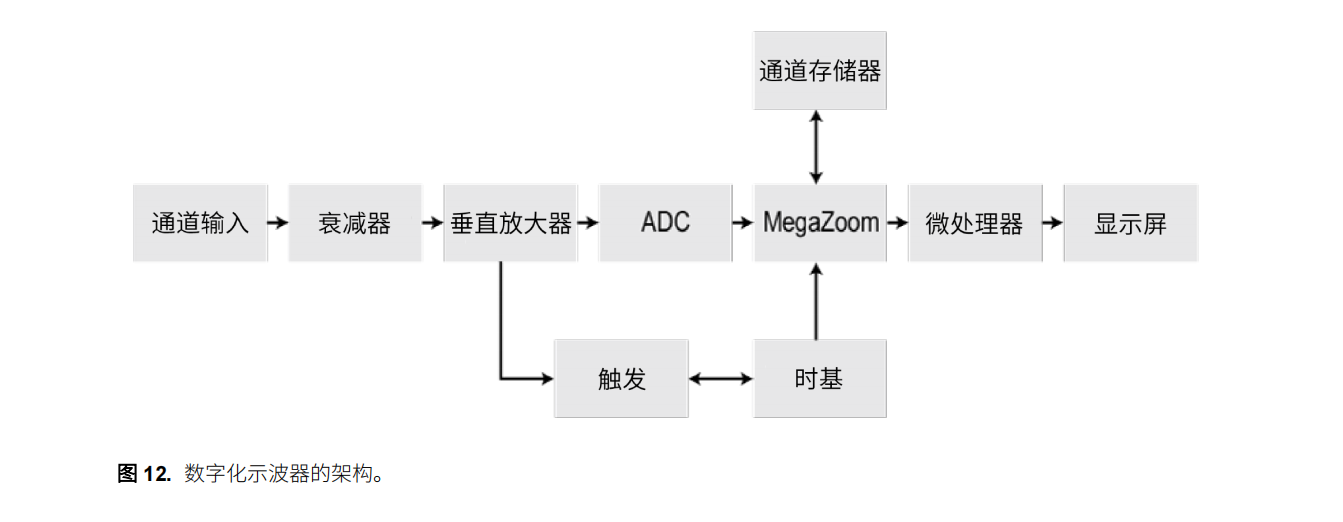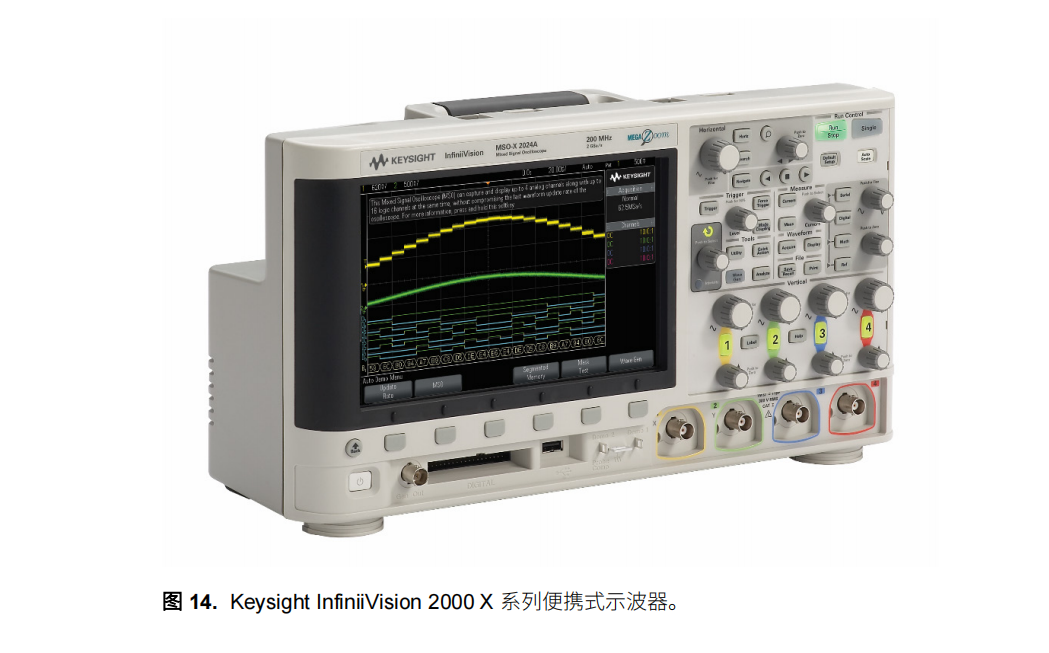Oscilloscope science --- the use of oscilloscopes and types
An oscilloscope is a test and measurement instrument used to display a variable as a function of another variable. For example, it can plot voltage (y-axis) versus time (x-axis) on a display. Figure 10 is an example of such a graph. This is very useful if you want to test whether an electronic component is working properly. If you know what the signal waveform should look like when the component is withdrawn, you can use an oscilloscope to see if the component is actually outputting the correct signal. Note that the x and y axes are divided into multiple parts by the grid. While most measurements can be performed automatically and with more accurate results for modern oscilloscopes, the grid allows you to make measurements by visual estimation. An oscilloscope has more features than just the ability to plot voltage versus time.
The oscilloscope has multiple inputs, called channels, each of which can work independently. So you can connect channel 1 to one device and channel 2 to another. The oscilloscope can then plot the relationship between the voltage measured on channel 1 and the voltage measured on channel 2. This mode is called the XY mode of the oscilloscope. This mode is useful when plotting I-V plots or Lissajous plots, where the shape of the plot allows you to know the phase difference and frequency ratio between the two signals. Figure 11 shows the Lissajous plots and the phase difference/frequency ratio they represent.

Analog Oscilloscopes
The earliest oscilloscopes were analog oscilloscopes that used cathode ray tubes to display waveforms. When an electron hits the screen, the phosphor on the screen glows, and you can see how the signal behaves when a continuous stream of phosphor glows. A trigger is required to make the displayed waveform look stable. When a complete trace is displayed, the oscilloscope waits until the next specific event occurs (e.g., a rising edge across a voltage) and then starts displaying the trace again. An untriggered display cannot be used because the waveform does not appear as a stable waveform on the display (this is also true for DSO and MSO oscilloscopes, as discussed later).
Analog oscilloscopes are very useful because the glowing phosphorescent powder does not disappear immediately. You can see multiple traces of the oscilloscope overlapping each other, so you can see burrs or irregularities in the signal. Because the waveform is displayed only when the electrons hit the screen, the strength of the displayed signal is directly related to the strength of the actual signal. This makes the display equivalent to a three-dimensional graph (in other words, the x-axis is time, the y-axis is voltage, and the z-axis is intensity). The disadvantage of an analog oscilloscope is that it does not "freeze" the display and does not allow the waveform to be retained for a longer period of time. Once the phosphorus spreads, that part of the signal disappears.
In addition, measurements of the waveform cannot be performed automatically. Instead, measurements must be performed using the grid on the display. Because of the limited horizontal and vertical scanning speed of the electron beam, the analog oscilloscope is also very limited in the types of signals it can display. Although many people still use analog oscilloscopes, they are no longer available in the marketplace. Nowadays, digital oscilloscopes have become the modern mainstream tool.
Digital Storage Oscilloscope (DSO)
The digital storage oscilloscope (often called DSO) was invented to make up for the many shortcomings of analog oscilloscopes. The DSO inputs a signal, which is then digitized by an analog-to-digital converter. Figure 12 shows one of the DSO architectures used in the ZTE digital oscilloscopes. It uses an attenuator to scale the waveform. A vertical amplifier provides additional scaling when passing the waveform to the analog-to-digital converter (ADC). The analog-to-digital converter samples the input signal and digitizes it. Then, the data is stored in memory.
The trigger searches for trigger events, and the time base adjusts the oscilloscope's time display. Before the oscilloscope finally displays the signal, the microprocessor system performs any post-processing you specify. Keeping the data in digital form allows the oscilloscope to make a variety of measurements on the waveform. Signals can also be stored in memory for long periods of time. This data can be printed or transferred to a computer via flash memory, LAN, USB or DVD-RW. In fact, you can now use the virtual front panel to control and monitor the oscilloscope from a computer.
Mixed Signal Oscilloscope (MSO)
In a DSO, the input signal is an analog signal that is digitized by an analog-to-digital converter. However, with the development of digital electronics, it has become increasingly necessary to monitor analog and digital signals simultaneously. Therefore, oscilloscope manufacturers have started to produce mixed-signal oscilloscopes that can trigger and display both analog and digital signals. Typically, these oscilloscopes have fewer analog channels (2 or 4) and more digital channels (8 or 16, see Figure 13).13 The advantage of a mixed-signal oscilloscope is the ability to trigger a combination of analog and digital signals and display them all on the same time base.

Portable / handheld oscilloscope
As the name implies, a portable oscilloscope is an oscilloscope that is small enough to carry around with you. If you need to take your oscilloscope to multiple locations or move from bench to bench in the lab, a portable oscilloscope may be perfect for you. Figure 14 shows a portable oscilloscope, a Keysight InfiniiVision X Series oscilloscope. Portable oscilloscopes have the advantage of being lightweight, portable, fast to turn on and off, and easy to use. Their performance is often lower than that of larger oscilloscopes, but the Keysight InfiniiVision 1000, 2000 and 3000T X-Series scopes are changing that. These oscilloscopes have all the portability and ease-of-use features common to portable oscilloscopes, but are also powerful enough, with bandwidths up to 6 GHz, to handle most of today's debugging needs

Economy oscilloscope
Economical oscilloscopes are inexpensive, but their performance is not as good as high-performance oscilloscopes. This type of oscilloscope is usually used in university laboratories. The main advantage of these oscilloscopes is their low price. For a relatively low price, you can get a very useful oscilloscope.
High Performance Oscilloscopes
High performance oscilloscopes offer the best performance available. For users who need an oscilloscope with high bandwidth, fast sampling and update rates, large memory depth, and many measurement capabilities, a high-performance oscilloscope is the best choice. A high-performance oscilloscope, the Keysight Infiniium 90000A Series, is shown in Figure 15. The main advantage of a high-performance oscilloscope is that it allows you to properly analyze a wide range of signals and provides many applications and tools to analyze current technology more easily and quickly. The main disadvantage is the high price and large size.
Where oscilloscopes are used
If a company is testing or using electronic signals, it is likely to have an oscilloscope. Thus, there are many applications for oscilloscopes:
- Automotive technicians use oscilloscopes to diagnose electrical problems in cars.
- University laboratories use oscilloscopes to teach students about electronics.
- Research organizations around the world use oscilloscopes.
- Cell phone manufacturers use oscilloscopes to test the integrity of cell phone signals.
- The military and aerospace industries use oscilloscopes to test radar communication systems.
- R&D engineers use oscilloscopes to test and design new technologies.
- Oscilloscopes are also used for compliance testing.
For example, USB and HDMI compliance testing: the output of USB and HDMI must meet certain standards. These are just a few of the uses of an oscilloscope. And it is indeed a powerful and versatile instrument.

Trigger Controls
As we mentioned earlier, the trigger signal helps provide a stable, usable display, and you can synchronize the oscilloscope's acquisition of the waveform you are interested in.
The Trigger control lets you select the vertical trigger level (for example, the voltage at which you want the oscilloscope to trigger), as well as choose among various trigger functions. Common trigger types include:
- Edge trigger Edge trigger is the most popular trigger mode. The trigger occurs when the voltage exceeds a set threshold. You can choose whether to trigger on the rising or falling edge. Figure 18 shows a graphical representation of triggering on the rising edge.
- Burr Trigger Burr trigger mode allows you to trigger an event or pulse with a width greater or less than a specified length of time. This feature is useful for finding random burrs or errors. If these burrs occur infrequently, it is difficult to see them. However, burr triggering allows you to catch many of these errors.
An oscilloscope is a test and measurement instrument used to display a variable as a function of another variable. For example, it can plot voltage (y-axis) versus time (x-axis) on a display. Figure 10 is an example of such a graph. This is very useful if you want to test whether an electronic component is working properly. If you know what the signal waveform should look like when the component is withdrawn, you can use an oscilloscope to see if the component is actually outputting the correct signal. Note that the x and y axes are divided into multiple parts by the grid. While most measurements can be performed automatically and with more accurate results for modern oscilloscopes, the grid allows you to make measurements by visual estimation. An oscilloscope has more features than just the ability to plot voltage versus time.
The oscilloscope has multiple inputs, called channels, each of which can work independently. So you can connect channel 1 to one device and channel 2 to another. The oscilloscope can then plot the relationship between the voltage measured on channel 1 and the voltage measured on channel 2. This mode is called the XY mode of the oscilloscope. This mode is useful when plotting I-V plots or Lissajous plots, where the shape of the plot allows you to know the phase difference and frequency ratio between the two signals. Figure 11 shows the Lissajous plots and the phase difference/frequency ratio they represent.

Analog Oscilloscopes
The earliest oscilloscopes were analog oscilloscopes that used cathode ray tubes to display waveforms. When an electron hits the screen, the phosphor on the screen glows, and you can see how the signal behaves when a continuous stream of phosphor glows. A trigger is required to make the displayed waveform look stable. When a complete trace is displayed, the oscilloscope waits until the next specific event occurs (e.g., a rising edge across a voltage) and then starts displaying the trace again. An untriggered display cannot be used because the waveform does not appear as a stable waveform on the display (this is also true for DSO and MSO oscilloscopes, as discussed later).
Analog oscilloscopes are very useful because the glowing phosphorescent powder does not disappear immediately. You can see multiple traces of the oscilloscope overlapping each other, so you can see burrs or irregularities in the signal. Because the waveform is displayed only when the electrons hit the screen, the strength of the displayed signal is directly related to the strength of the actual signal. This makes the display equivalent to a three-dimensional graph (in other words, the x-axis is time, the y-axis is voltage, and the z-axis is intensity). The disadvantage of an analog oscilloscope is that it does not "freeze" the display and does not allow the waveform to be retained for a longer period of time. Once the phosphorus spreads, that part of the signal disappears.
In addition, measurements of the waveform cannot be performed automatically. Instead, measurements must be performed using the grid on the display. Because of the limited horizontal and vertical scanning speed of the electron beam, the analog oscilloscope is also very limited in the types of signals it can display. Although many people still use analog oscilloscopes, they are no longer available in the marketplace. Nowadays, digital oscilloscopes have become the modern mainstream tool.
Digital Storage Oscilloscope (DSO)
The digital storage oscilloscope (often called DSO) was invented to make up for the many shortcomings of analog oscilloscopes. The DSO inputs a signal, which is then digitized by an analog-to-digital converter. Figure 12 shows one of the DSO architectures used in the ZTE digital oscilloscopes. It uses an attenuator to scale the waveform. A vertical amplifier provides additional scaling when passing the waveform to the analog-to-digital converter (ADC). The analog-to-digital converter samples the input signal and digitizes it. Then, the data is stored in memory.
The trigger searches for trigger events, and the time base adjusts the oscilloscope's time display. Before the oscilloscope finally displays the signal, the microprocessor system performs any post-processing you specify. Keeping the data in digital form allows the oscilloscope to make a variety of measurements on the waveform. Signals can also be stored in memory for long periods of time. This data can be printed or transferred to a computer via flash memory, LAN, USB or DVD-RW. In fact, you can now use the virtual front panel to control and monitor the oscilloscope from a computer.
Mixed Signal Oscilloscope (MSO)
In a DSO, the input signal is an analog signal that is digitized by an analog-to-digital converter. However, with the development of digital electronics, it has become increasingly necessary to monitor analog and digital signals simultaneously. Therefore, oscilloscope manufacturers have started to produce mixed-signal oscilloscopes that can trigger and display both analog and digital signals. Typically, these oscilloscopes have fewer analog channels (2 or 4) and more digital channels (8 or 16, see Figure 13).13 The advantage of a mixed-signal oscilloscope is the ability to trigger a combination of analog and digital signals and display them all on the same time base.

Portable / handheld oscilloscope
As the name implies, a portable oscilloscope is an oscilloscope that is small enough to carry around with you. If you need to take your oscilloscope to multiple locations or move from bench to bench in the lab, a portable oscilloscope may be perfect for you. Figure 14 shows a portable oscilloscope, a Keysight InfiniiVision X Series oscilloscope. Portable oscilloscopes have the advantage of being lightweight, portable, fast to turn on and off, and easy to use. Their performance is often lower than that of larger oscilloscopes, but the Keysight InfiniiVision 1000, 2000 and 3000T X-Series scopes are changing that. These oscilloscopes have all the portability and ease-of-use features common to portable oscilloscopes, but are also powerful enough, with bandwidths up to 6 GHz, to handle most of today's debugging needs

Economy oscilloscope
Economical oscilloscopes are inexpensive, but their performance is not as good as high-performance oscilloscopes. This type of oscilloscope is usually used in university laboratories. The main advantage of these oscilloscopes is their low price. For a relatively low price, you can get a very useful oscilloscope.
High Performance Oscilloscopes
High performance oscilloscopes offer the best performance available. For users who need an oscilloscope with high bandwidth, fast sampling and update rates, large memory depth, and many measurement capabilities, a high-performance oscilloscope is the best choice. A high-performance oscilloscope, the Keysight Infiniium 90000A Series, is shown in Figure 15. The main advantage of a high-performance oscilloscope is that it allows you to properly analyze a wide range of signals and provides many applications and tools to analyze current technology more easily and quickly. The main disadvantage is the high price and large size.
Where oscilloscopes are used
If a company is testing or using electronic signals, it is likely to have an oscilloscope. Thus, there are many applications for oscilloscopes:
- Automotive technicians use oscilloscopes to diagnose electrical problems in cars.
- University laboratories use oscilloscopes to teach students about electronics.
- Research organizations around the world use oscilloscopes.
- Cell phone manufacturers use oscilloscopes to test the integrity of cell phone signals.
- The military and aerospace industries use oscilloscopes to test radar communication systems.
- R&D engineers use oscilloscopes to test and design new technologies.
- Oscilloscopes are also used for compliance testing.
For example, USB and HDMI compliance testing: the output of USB and HDMI must meet certain standards. These are just a few of the uses of an oscilloscope. And it is indeed a powerful and versatile instrument.

Trigger Controls
As we mentioned earlier, the trigger signal helps provide a stable, usable display, and you can synchronize the oscilloscope's acquisition of the waveform you are interested in.
The Trigger control lets you select the vertical trigger level (for example, the voltage at which you want the oscilloscope to trigger), as well as choose among various trigger functions. Common trigger types include:
- Edge trigger Edge trigger is the most popular trigger mode. The trigger occurs when the voltage exceeds a set threshold. You can choose whether to trigger on the rising or falling edge. Figure 18 shows a graphical representation of triggering on the rising edge.
- Burr Trigger Burr trigger mode allows you to trigger an event or pulse with a width greater or less than a specified length of time. This feature is useful for finding random burrs or errors. If these burrs occur infrequently, it is difficult to see them. However, burr triggering allows you to catch many of these errors.







